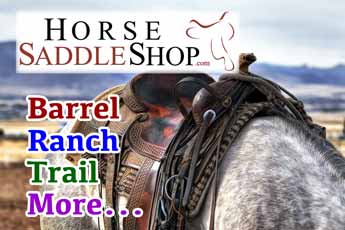Cowboy Dictionary - Letter S
Saddle Horse - A horse that has been trained to carry a saddle and be ridden.
Saddle Riggings - On a Western saddle, the term "rigging" refers to the position of the front cinch, and/or to whether or not a saddle also has a back cinch (sometimes called a "flank cinch"). Here is a quick breakdown of some common rigging terms.
Full Rigging: The front cinch position is the full distance from the cantle to the pommel. This puts the front cinch directly beneath the pommel of the saddle.
7/8 Rigging: The front cinch position is 7/8 of the distance from the cantle to the pommel. This puts the front cinch a little farther back than a full rigged saddle.
Below: Common saddle rigging positions.
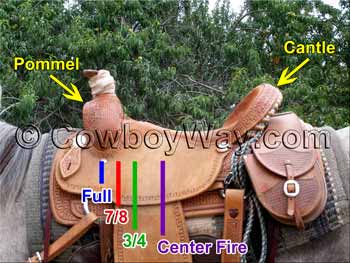
3/4 Rigging: The front cinch position is 3/4 of the distance from the cantle to the pommel. This puts the front cinch a little farther back than a 7/8 rigged saddle.
Center Fire Rigging: The front cinch position is (approximately) centered between the cantle and the pommel.
Single Rigged: This means there is a front cinch, but not a back cinch (sometimes called a "flank cinch"). The term "single rigged," by itself, does not let you know the position of the front cinch (full, 7/8, etc.).
Double Rigged: This means there is a front cinch and a back cinch. The term "double rigged," by itself, does not let you know the position of the front cinch (full, 7/8, etc.).
Full Double Rigged: This means there is a front cinch and a back cinch, and that the front cinch is in the "full" position (the full distance from the cantle to the pommel).
Saddle Tree - A saddle tree is the foundation upon which the rest of the saddle is built.
Below: A wood saddle tree.
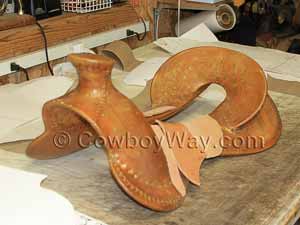
Since the tree of a finished saddle is covered with leather or other materials, the tree cannot be seen except from underneath the saddle and then only a small amount of the tree is visible.
Saddle trees have traditionally been made of wood, but can also be made of other materials.
Advertisement - Article continues below.
Section - When referring to acreage, a section is 640 acres. If a section is square in shape, it is one mile long on all four sides.
Shotgun Chaps - Shotgun chaps, or "shotguns," are a type of leather leg covering worn by cowboys and cowgirls for protection against weather, trees, brush, kicks, rope burns, and other hazards. For a picture of shotgun chaps please see our page Cowboy Dictionary - Letter C and look for the definition of "chaps."
You can shop for chaps here.
Sire - The term given to a stallion (male horse) when he becomes a father.
Slobber Straps - Slobber straps are pieces of leather that attach reins to a bit. They can be plain or fancy.
Below: Slobber straps.
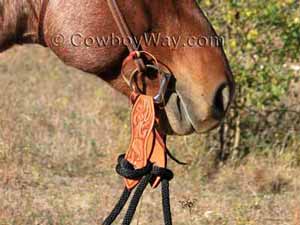
Slobber straps generally serve three purposes:
- They can take a lot of everyday wear and tear off of expensive reins. For example, if a horse takes a drink while wearing reins with slobber straps, the slobber straps will help keep the reins out of the water.
- Some reins can be very lightweight. Slobber straps can add enough weight to the end of the reins that the horse can more easily feel communications through the reins from the rider.
- Some styles of reins, such as mecates, are not easily attached directly to a bit. In this case, the slobber strap is attached to the bit and the mecate is attached to the slobber strap.
You can shop for slobber straps here.
Smooth or Smooth Mouthed - A horse nine years of age or older.
In most cases, a horse's age can be ascertained by its teeth until approximately age nine. After that, the age identifying characteristics in a horse's mouth "smooth," or become less distinguished.
The terms "smooth" or "smooth mouthed" are used less commonly today than in years past due to the high number of horses that are now registered with various breed organizations. With registrations keeping track of a horse's age, horses can now easily be described by their actual age instead of a more general term such as "smooth."
Split Reins - Split reins run from the bit to the rider's hands and are used for communicating with the horse while riding. Split reins are two separate, individual reins that are used together, with one rein on each side of the horse's neck.
Below: A working cowboy riding with split reins.
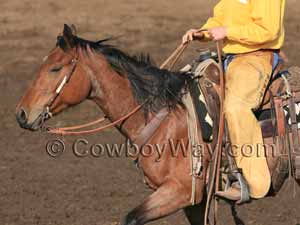
Spats - On horses, the word spats refers to the long hairs that hang down over the hooves. Not all horses have spats.
Spats are a common characteristic of draft horses. Horses that have spats also commonly have "feathers," which are long hairs on the back of the lower leg.
Below: The red arrows are pointing to spats, and the blue arrows are pointing to feathers.
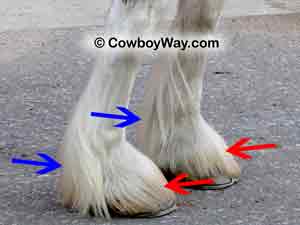
Spur Ledge - The lip, or extension, on the back of a boot heel where a spur rests. Also called a "spur rest."
Below: A spur ledge.
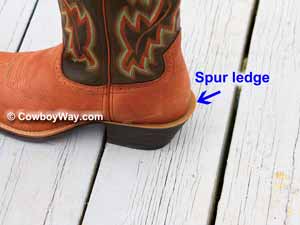
Below: Spurs resting on a spur ledge.
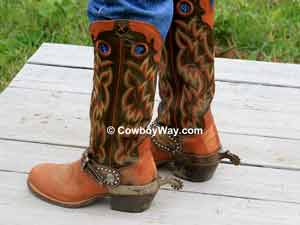
Stallion - A male horse that has not been castrated.
Stampede String - A "stampede string" is a string used to hold a cowboy hat on a person's head. Stampede strings range from the plain but functional (a simple string of leather) to the fancy and fashionable (braided leather or horsehair, colorful, etc.).
Below: A stampede string.
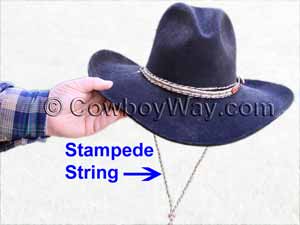 .
.
Steer - A castrated male animal belonging to the genus Bos, which includes the species cattle.
Straw - Straw is the dry stems of certain plants.
Straw is usually considered to be a by-product left over after the plant's main product, such as grain, has been harvested. After harvest the straw remaining is the field is sometimes burned, plowed under or otherwise disposed of, but it is often allowed to dry and then baled for easier transportation so it can be used for a variety of purposes.
Perhaps the best-known use for straw is for animal bedding, although other products, such as sawdust, have become more common in many areas for this purpose. Other uses for straw include erosion control, construction, as a product in animal feed, crafts, and more.
Below: A round bale of wheat straw.
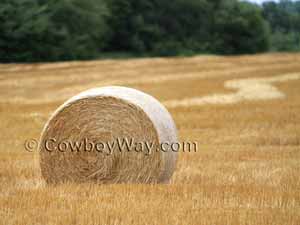
Stripping Chute - A chute at a rodeo arena used to take equipment off of broncs and bulls, and roping steers.
At a rodeo arena there are usually two stripping chutes. One stripping chute is located near the bucking chutes and is where the broncs and bulls, after they have finished bucking, have their bareback riggins', bronc saddles, or bull flanks removed.
The other stripping chute is located at the opposite end of the arena from the roping boxes. This stripping chute, sometimes called the "steer stripping chute" is where the roping steers, after they have been roped, have their head ropes and/or their heel ropes removed.
Below: A steer walking into the stripping chute to have his head rope removed.
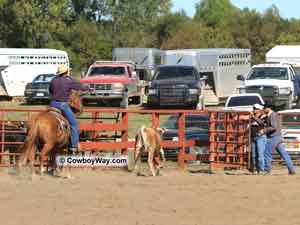
Swayback - A swaybacked horse has a spine that dips abnormally low between the withers and the hip. The proper name for swayback is "lordosis."
There are degrees of swayback: A a horse's spine may dip downward a little or a lot. Although the condition is sometimes quite dramatic looking, swaybacked horses usually live healthy, normal lives.
Below: A swaybacked horse.
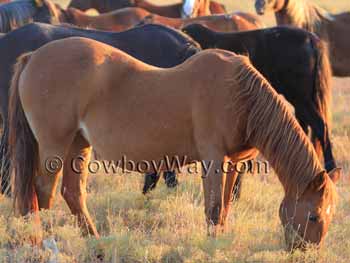
Definitions
… Letter C
… Letter S
… Letter T
You Might Also Like
